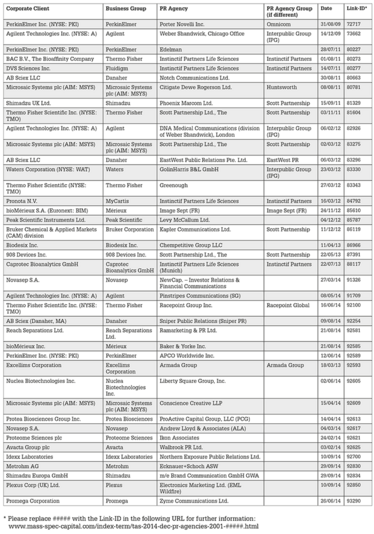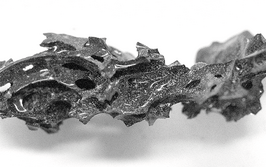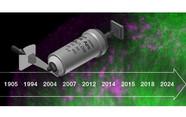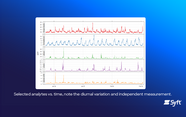How to Get PR Right
How do your customers, your competitors, the press or even the public perceive your organization? Here, I offer my tips, tricks and thoughts on PR – and suggest why you might want to consider a smarter approach.
Over the last few years, I’ve come to a number of conclusions about the role and usefulness of public relations agencies – and PR in general – in the analytical industry. You may be the manager of a non-listed small to mid-size analytical company that doesn’t have its own PR manager or department. Or you might run a mid-size to large research organization that has a lot to gain by establishing professional PR strategies. Or maybe you run a small lab or research group. The point is the same: getting your message out in front of the right people at the right time can pay dividends down the road. Perhaps you’re just wondering why your excellent innovation isn’t proudly showcased in the TASIAs – did you tell anyone about it?

Thank you – or not
First, let me describe a normal working week in my office. We get about 200–300 press releases, newsletters and news alerts. We select about 100 of these for archiving, and a selection of those for Twitter and/or manual indexing for inclusion in our database and web portals. From time to time, we send a return email to the company who sent the news: “Thanks for your update, we already tweeted your news!” or “Thank you for your press release, it will soon be online at our web portal!”
Perhaps we send 10–20 of those “thank-you-mails” a week. Why do we do it?
Because we are friendly? No, we are from Northern Germany and an unfriendly bunch of stubborn people.Because it helps our business? Sure. Each email includes our improperly large red logo, which can’t be overlooked and will be imprinted in the subconscious mind of the addressee forever, whether he or she likes it or not.
Because it is useful for the person who sends the news to us? Definitely. It helps the sender see immediately that the news has been received and where it has been published. No need for tracking.
Now a question. How many people respond to our thank-you-mail with a return email simply saying, “Thank you!” with their name? Well, approximately one person.
It’s very likely that the one person who does respond works for a PR agency.
Do I really need a PR agency?
PR agency personnel take PR very seriously and know the essentials; it is the way they make their living, after all. Therefore, if you take PR efforts seriously and know the ‘basic’ essentials you may not necessarily need an agency. If you don’t, then you probably do.
The press release is a cornerstone of PR – do you know the bare essentials? It must:
- Have a short and interesting title
- Use a subtitle to provide a very quick overview of the main message in plain language
- Include a date (and place)
- Include at least three paragraphs: i) the main message, ii) some more interesting and supporting details, iii) a quote from relevant person(s)
- Include the name of a contact person (including email address)
- Provide a short profile of the company/institution.
That’s it. If every press release we received followed these basics, we would be delighted.
I urged the inclusion of a quote above, but I would strongly recommend not using more than two. And please don’t write, “Ms. A and Mr. B said, ‘We are proud of this achievement’”. It brings tears to my eyes when I imagine both parties trying to say the words in unison, standing side by side.
Beyond the basics
If your company or research institution strives to go beyond the bare essentials in analytical science, why not go beyond the bare essentials in terms of PR to represent your organization accordingly?
- Put a PR strategy in place. In other words, choose the right format and media outlet for the right message. For example, we at [iito] Business Intelligence are interested in business topics. If you send us great and exciting news about a new sample preparation technology for MALDI-TOF-MS with a detailed scientific description, it will probably end up in our office dustbin. However, if you license that technology to one or several of the big MS players, it will surely end up at the top of our web portal and in our newsletter. On the otherhand, it may be the other way round in The Analytical Scientist.
- Pay attention to professional branding (for example, logos, lettering, style).
- Try to understand words as well as molecules. In other words, produce intelligent text to represent your intelligent chemical analyses.
- Try to get to know and understand your (PR) customers (in general and in person).
Say “Thank you”
No doubt, there will be somebody within your organization who has the capabilities to perform the basics and even go beyond the basics, but it certainly takes time, especially if you plan to issue many press releases each year.
Taking the PR plunge
So, you’ve decided to outsource your PR. Which type of agency is right for you?
Start small? There are many small PR agencies around, simply because starting a PR agency has low barriers to entry; there is no need for large capital investment, patents or copyrights. Such agencies may be single person ventures, or they may have up to twenty people. If you only want to publish a few press releases a year but need good advice and some PR work done in a professional way, a small agency may be the best fit. They will be close, and willing to act in a fast and flexible manner at lower cost.
Go specialized? Industry specialized agencies tend to employ 20–50 people, handle more clients, and charge higher rates. However, they have the critical mass to provide you with a complete package in your niche market that goes far beyond issuing a few press releases a year. Such agencies are often very close to your market and can be partners for many years as your company grows, even worldwide – especially as it is common for such agencies to have partners of the same size in other regions.
Dive straight in at the deep end? Other agencies act as arms of the largest PR business groups in the world. Very often these groups are big players with billions of dollars in revenue. In most cases, you will deal with a special brand of these groups, active in the life sciences or laboratory equipment market, and not the corporate brand of the large business group. The big PR firms can provide anything you need to place your offering on worldwide markets – along with a price tag that may reflect their stature. They certainly have the critical mass, and if time matters, it can make a big difference.
In Table 1 (at the end of this article), you will find a (non-definitive) list of PR agencies and the companies they work with based on press announcements. We also share two PR agency profiles. Why two? Well, somewhat ironically only two PR agencies replied to our request for more information...
Personal PR highpoints
Apart from the basics, sometimes it’s the small but memorable things that set certain PR agencies apart. In the end, everybody is playing the same chords, but some do it better or differently than others, in either case, a special touch always does the trick. I should note that the following three ‘special impressions’ are very personal – other journalists and editors may have totally different perspectives and experiences. *
The woman at the door
At my first Analytica, I was at a press conference for one of the largest players in the mass spectrometry and chromatography industries. A small, but very “present” woman drew my attention. She was the boss and founder of the PR agency who invited me, and she stood guard at the main door when the press conference had begun. When somebody wanted to leave the room during the press conference, she opened the door for them and closed it behind them as silently as she could. I was deeply impressed. She was the boss but kept her finger on the door to avoid any disturbance. Over the last few years, her agency has grown to nearly 50 people and also expanded regionally. My compliments.
The press dinner
I don’t know why I got invited or who invited me, but I visited my first press dinner of a major analytics firm at Analytica 2012 in Munich. There were a dozen or so top and middle managers from the company, a handful of people from the PR agency, and about 20 colleagues from the press. A nice place, good food and wine – and not soon forgotten.
In fact, it was the best PR event I have attended to date. The right people to talk to; not too many, but not very few. We were able to speak to managers and thereby get first-hand information from decision makers. We chatted with the PR people as well as our colleagues and competitors. You know, sometimes your best competitors are also your best colleagues and business partners. I’ve attended this event three times in the last three years and actually met the guys from The Analytical Scientist at the second press dinner. Now I am writing this article for them, and some of their articles are regularly featured in our [MSC] Newsletter and on our web portal at Mass-Spec-Capital.com. Yes, certainly not to be forgotten; all the managers and people from the agency are on our mailing list. Perfect.
The funny, smart guys & girls
One day, I received a news release from a UK agency that I have never heard of before. It had a funny introduction and was followed by that all important thank-you-mail. I visited their website and it made me smile. So, I made some fun about how clever and smart they were, and that we Germans seemed to be lagging behind. A woman on the team replied, “Yes, we are a clever bunch!” I could not describe it any better myself – very clever and nice people. The agency owner has been sending me news of his life science clients ever since and, if I don’t immediately respond, he just reminds me, “Marcus, did you get my news – has it not been of interest to you?” You can bet that, after his reminder, I try to tweet his news as fast as I can (no payment involved!). This is a small, young agency that will most likely succeed.
To sum up: being fast, competent, funny, smart, friendly, a little bit “pushy”, and paying attention to details – as well as having stamina – is a recipe for success.
The best strategy?
One conclusion stands out: take care of the essentials. Everything else is an extra option, but not necessary. Simply take care of the bare essentials and we will always be happy to receive your news!
In general, I would not recommend for or against a special type of agency – it always depends on your needs and preferences. It is also possible to have a mix: you could have a small company by your side (as some type of external-internal consultant) while you’re talking or working with bigger agencies.
Remember that PR work does not end with the concept of your news release and the concrete text. It also includes the design and the corporate branding and style. If you include a ‘lousy’ logo in a fine press release, the release will suffer – and the other way round.
It’s like a chemical analysis: everything – from the concept, over sample preparation, the instrument used, the test run on the system, the software analysis, to the documentation – is important.
PR is a serious business supporting the critical commercial mission of your company and not a weekend hobby for the managing director. The weekend would definitely be better spent with family.
So, if the news you are trying to bring to the market is serious – and indeed, it should be – try to bring in a professional “operator” to place your call, unless you can do it all by yourself to (nearly) the same standard, with the same speed. It has all been sung before...
Long-distance operator,
Place this call, it’s not for fun.
Long-distance operator,
Please, place this call,
you know it’s not for fun.
I gotta get a message to my baby,
You know, she’s not just anyone.
– “Long Distance Operator”, The Band (lead vocal Richard Manuel, written by Bob Dylan).
Marcus Lippold is an Economist and Head of [iito] Business Intelligence as well as Editor-in-Chief of Mass-Spec-Capital.com, the free business web portal for the worldwide mass spectrometry industry. [iito] Business Intelligence is based in Bremen, Germany.
*Conflict of interest declaration.
I hereby confirm that there is no conflict of interest. The PR agencies mentioned in the examples have never placed an order with [iito].

Table 1: PR agencies and who they work for (based on public announcements)
PR Profiles
Notch Communications
“Notch Communications, like the signalling molecule, is vital for the development and success of scientific businesses #CreatingBrilliance”
Notch Communications Ltd, 76 King Street, Manchester, UK.
Notch Communications AB, Uppsala Science Park, Dag Hammarskjölds väg 26, Uppsala 75237, Sweden.
Founded: 2011 by Peter Brown and Kate Whelan
Number of Employees: 25
Services offered:
• Brand strategy and management
• Strategic marketing and planning
• Creative advertising, marketing and direct response
• Press and public relations
• Website design and development
• Social and digital media
• Scientific and technology marketing
• Internal marketing
• Media planning and buying
• Exhibitions and product launches
“Analytical” Customers:
AB SCIEX, Dr. Reddy’s CPS, Xerox Research Centre Canada. Activities include brand and brand management, media relations, PR and news, bylined articles, white papers, technical writing, scientific conferences, press conferences and exhibitions.
Agency profile:
Notch Communications offers scientific and technology marketing expertise that’s renowned across the world of life science. Its people have created brands for some of the world’s largest and smaller life science companies, and Notch has masterminded powerful multi-media campaigns to deliver effective, high impact results in the life sciences and analytical markets.
Inspiration for the agency name came from the notch signalling pathway. Notch is a vital signalling molecule for relaying messages between living cells. It’s especially important during development, which requires notch signalling to get the right message, in the right quantities, to the appropriate target receptors. Notch employs highly skilled marketing and digital experts along with trained scientists to deliver a uniquely scientific approach to designing, implementing and measuring campaigns. Through analytical and strategic thinking, we determine effective and long-lasting ways to help businesses stand out from their competitors. We offer powerful creative ideas and the full range of digital and print design services. We are well connected throughout the global analytical and life science trade press sectors, helping clients to reach key opinion leaders and influencers in their chosen markets. Through our customized PR, outstanding social media campaigns, digital and advertising expertise, Notch creates brilliance.
ramarketing & PR
“We are ramarketing. An award-winning marketing & PR agency based in Newcastle. Our mission is to help brands & companies get noticed.”
Arch 2, Westgate Road, Newcastle upon Tyne, NE1 1SA
Founded: 2009
Number of Employees: 7
Services offered:
• Marketing
• PR
• SEO
• Social media
• Design
• Digital PPC
• Events
“Analytical” Customers:
Molecular Profiles, Onyx Scientific, Reach Separations, The Specials Laboratory, Innovative Physical Organic Solutions, Edwards Analytical
Agency profile:
ramarketing is a marketing and PR agency that’s in the business of helping ambitious pharmaceutical, healthcare and manufacturing companies get noticed.
Working with the likes of The Specials Laboratory, Onyx Scientific, Fertin Pharma, Molecular Profiles and Reach Separations, ramarketing’s model allows it to offer senior manager expertise across all services in cost-effective manner. Providing clients with an outsourced marketing solution, the agency has built a reputation for delivering tangible outcomes and value for money.
Specialising in devising and implementing integrated marketing campaigns, the firm offers traditional marketing and digital campaigns that include PR, design, social media, search engine optimisation, pay-per-click and content creation to businesses both in the UK and abroad.
Marcus Lippold, an economist by training, was born in Bremen, Germany (where he remains). “Actually, I started out as singer and songwriter in a band and wrote over 100 hundred German-language songs,” he says. Marcus also worked for eight years as a researcher at the University of Bremen, focusing on intellectual property rights and organization in the biotech and pharma industry. “In 2003, I founded [iito] Business Intelligence for the life sciences market,” says Marcus, “And in 2010, [iito] launched the business web portal Mass-Spec-Capital.com, dedicated to the worldwide mass spec industry, with two further life sciences web portals following suit”.

















